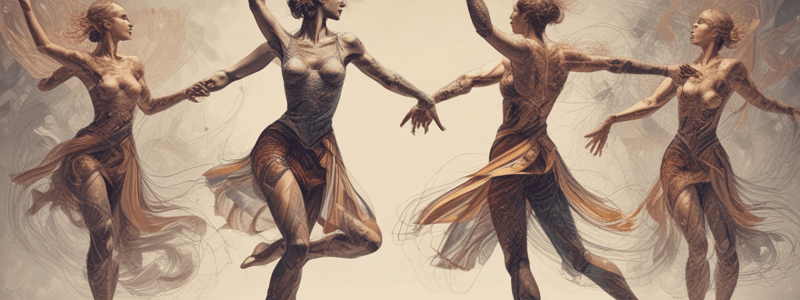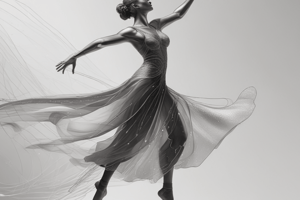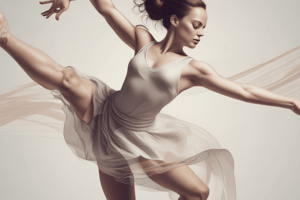Podcast
Questions and Answers
What is the primary role of body mechanics in dance?
What is the primary role of body mechanics in dance?
What is essential for executing isolations in dance?
What is essential for executing isolations in dance?
What is crucial for effective floor work in dance?
What is crucial for effective floor work in dance?
Why is warming up and stretching important before acrobatic movements?
Why is warming up and stretching important before acrobatic movements?
Signup and view all the answers
What is essential for efficient execution of acrobatic movements?
What is essential for efficient execution of acrobatic movements?
Signup and view all the answers
What is a key aspect of isolations in dance?
What is a key aspect of isolations in dance?
Signup and view all the answers
Why is engaging the core essential in dance movements?
Why is engaging the core essential in dance movements?
Signup and view all the answers
What is a benefit of understanding and applying body mechanics in dance?
What is a benefit of understanding and applying body mechanics in dance?
Signup and view all the answers
What is crucial for executing jumps and leaps effectively?
What is crucial for executing jumps and leaps effectively?
Signup and view all the answers
What should you do before executing a jump or leap?
What should you do before executing a jump or leap?
Signup and view all the answers
What muscles should you engage to generate power for a jump or leap?
What muscles should you engage to generate power for a jump or leap?
Signup and view all the answers
What should you strive to achieve during a jump or leap?
What should you strive to achieve during a jump or leap?
Signup and view all the answers
How should you land after a jump or leap?
How should you land after a jump or leap?
Signup and view all the answers
What is essential for executing percussive movements?
What is essential for executing percussive movements?
Signup and view all the answers
What should you focus on when performing acrobatic movements?
What should you focus on when performing acrobatic movements?
Signup and view all the answers
What should you develop to excel in contemporary dance?
What should you develop to excel in contemporary dance?
Signup and view all the answers
What is important to refine when applying body mechanics in specific dance movements?
What is important to refine when applying body mechanics in specific dance movements?
Signup and view all the answers
What should you listen to when incorporating body mechanics into your dancing?
What should you listen to when incorporating body mechanics into your dancing?
Signup and view all the answers
What is the main purpose of understanding body mechanics in dance?
What is the main purpose of understanding body mechanics in dance?
Signup and view all the answers
What is the significance of aligning the body in the air during jumps and leaps?
What is the significance of aligning the body in the air during jumps and leaps?
Signup and view all the answers
What is the purpose of spotting in dance?
What is the purpose of spotting in dance?
Signup and view all the answers
What is turnout in dance?
What is turnout in dance?
Signup and view all the answers
What is the significance of engaging the core muscles during turns?
What is the significance of engaging the core muscles during turns?
Signup and view all the answers
What is the significance of arm placement during turns?
What is the significance of arm placement during turns?
Signup and view all the answers
What is the significance of weight transfer during turns?
What is the significance of weight transfer during turns?
Signup and view all the answers
Why is it important to maintain proper posture and alignment during turns?
Why is it important to maintain proper posture and alignment during turns?
Signup and view all the answers
What should you do when preparing for a turn?
What should you do when preparing for a turn?
Signup and view all the answers
Why is it important to find your center of balance before attempting turns and rotations?
Why is it important to find your center of balance before attempting turns and rotations?
Signup and view all the answers
What is the main reason for having a spotter present during partner work and lifts?
What is the main reason for having a spotter present during partner work and lifts?
Signup and view all the answers
What is the primary focus of regular conditioning and flexibility training for dancers?
What is the primary focus of regular conditioning and flexibility training for dancers?
Signup and view all the answers
What is essential for mastering any dance technique, including partner work and lifts?
What is essential for mastering any dance technique, including partner work and lifts?
Signup and view all the answers
What is the primary benefit of incorporating principles of body mechanics into partner work and lifts?
What is the primary benefit of incorporating principles of body mechanics into partner work and lifts?
Signup and view all the answers
What is the role of a spotter in partner work and lifts?
What is the role of a spotter in partner work and lifts?
Signup and view all the answers
What is essential for executing dance movements, especially when working with a partner?
What is essential for executing dance movements, especially when working with a partner?
Signup and view all the answers
What is crucial for successful partner work and lifts?
What is crucial for successful partner work and lifts?
Signup and view all the answers
What should you engage to maintain proper alignment throughout your body?
What should you engage to maintain proper alignment throughout your body?
Signup and view all the answers
What helps maintain balance, reduces dizziness, and assists in controlling the movement?
What helps maintain balance, reduces dizziness, and assists in controlling the movement?
Signup and view all the answers
What should you maintain to ensure stability and safety in lifts?
What should you maintain to ensure stability and safety in lifts?
Signup and view all the answers
What should you establish to ensure seamless transitions and prevent accidents or injuries?
What should you establish to ensure seamless transitions and prevent accidents or injuries?
Signup and view all the answers
What is important to practice in front of a mirror?
What is important to practice in front of a mirror?
Signup and view all the answers
What should you gradually build up to in turns and rotations?
What should you gradually build up to in turns and rotations?
Signup and view all the answers
What is vital for executing any dance movement?
What is vital for executing any dance movement?
Signup and view all the answers
What should you avoid doing to maintain balance?
What should you avoid doing to maintain balance?
Signup and view all the answers
Study Notes
Applying Body Mechanics to Dance Movements
- Body mechanics is crucial in dance, enabling efficient execution of movements, proper alignment, and injury prevention.
- Understanding and applying body mechanics enhances performance, elevates dance skills, and reduces the risk of injury.
Controlling Core Engagement in Isolations
- Isolations involve moving specific body parts while keeping the rest of the body still.
- Maintaining control over the core is essential for executing isolations.
- Stand tall with feet hip-width apart, engage abdominal muscles, and initiate movement from the targeted body part.
Applying Body Mechanics to Floor Work
- Floor work requires understanding weight distribution and body mechanics to transition smoothly between movements.
- Utilize core and leg strength to rise smoothly from the floor, avoiding strain on the back.
Incorporating Body Mechanics into Acrobatic Movements
- Acrobatic movements require a combination of strength, flexibility, and body mechanics.
- Proper alignment and engagement are crucial for efficiency and safety.
- Warm up and stretch thoroughly to prevent injuries.
Utilizing Body Mechanics in Percussive Movements
- Percussive movements rely on body mechanics to produce distinct sounds and maintain precision.
- Focus on grounding movements, utilizing full range of motion in joints, and creating tension in muscles to achieve the desired percussive effect.
- Practice isolating different body parts while maintaining overall coordination and rhythm.
Exploring the Nuances of Body Mechanics in Contemporary Dance
- Contemporary dance requires a strong understanding of body mechanics to execute fluid and expressive choreography.
- Explore the connection between breath and movement, as well as dynamic shifts of weight and momentum.
- Experiment with levels, direction changes, and different qualities of movement.
Analyzing the Body Mechanics Involved in Jumps and Leaps
- Maintaining proper alignment and posture is crucial for executing jumps and leaps effectively.
- Establish a preparatory position by bending knees, keeping back straight, and engaging core muscles.
- Generate power by using leg strength, particularly quadriceps and glutes.
- Maintain alignment during the jump, keeping legs extended and feet pointed.
- Land properly by absorbing impact, bending knees, and engaging core muscles.
Understanding the Mechanics of Turns and Rotations in Dance
- Turns and rotations require a solid understanding of body mechanics to execute with precision and control.
- Find your center of balance, using a straight line from the crown of the head to the supporting foot.
- Use spotting to maintain equilibrium and focus during turns.
- Utilize turnout, engaging core muscles and maintaining stability during rotations.
- Practice coordinating arm movements with turns to create fluidity and grace.
Examining the Use of Body Mechanics in Partner Work and Lifts
- Partner work and lifts require strength, coordination, and a thorough understanding of body mechanics.
- Establish a strong foundation by building core strength and proper alignment.
- Build trust and communication with your partner, understanding each other's capabilities and limitations.
- Practice weight sharing techniques, distributing weight evenly through the feet or supporting body parts.
- Use proper body alignment in lifts, maintaining a strong core and engaging supporting leg muscles.
- Utilize momentum and leverage to achieve impressive movements with minimal effort.
- Practice spotting techniques to maintain balance and control during lifts.
- Incrementally progress to more complex lifts, ensuring safety and proper technique.
- Incorporate regular conditioning and flexibility training to enhance strength and range of movements.
Studying That Suits You
Use AI to generate personalized quizzes and flashcards to suit your learning preferences.
Description
Explore the application of body mechanics in specific dance movements, focusing on efficient execution, proper alignment, and injury prevention.




